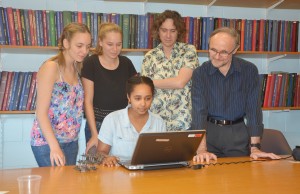Seven Year 10 girls from a Brisbane high school have gained an insight into life as a scientist at Griffith University.
The University has joined forces with The Growing Tall Poppies program, making it the first Queensland partner. The program aims to increase the number of students studying science to year 12 and beyond into university.
For Lourdes Hill College student Amy Lubrano experiencing life at university opened her eyes to a world of possibilities.
“I never realised how interdisciplinary science was until now,” shesaid.
“I thought it was either physics, chemistry or biology but they all work together to achieve a desired outcome.”
During the three day program at Nathan campus students were mentored by Associate Professor Francesca Iacopi, from Griffith’s Micro- and Nanotechnology Centre and Professor John Dobson and Dr Tim Gould from the Griffith School of Natural Sciences.
Students explored the making of graphene, a substance 100 times stronger than steel, and its important honeycomb structure and the basic cells that let scientists study it.
Associate Professor Iacopi, who is one of 16 high-level representatives in the Advance Queensland Expert Panel, said it was great to see so many young students interested in science.
“They are the future of the science industry; I hope they keep up their enthusiasm,” she said.
Growing Tall Poppies Program Director Eroia Barone-Nugent said the program had been extremely successful in Victoria, with 1964 participants involved in the program since 2008.
“We want to increase the number of students doing physics in particular to address the decrease we have seen in the last 20 years,” she said.
“Until that is addressed and instilled we won’t be able to see culture and stereotypes around girls in physics transformed.”
Ms Barone-Nugent said the program has resulted in 80 to 85% more girls continuing science studies to year 12.
Head of Griffith’s School of Natural Sciences Professor Robert Sang said he hoped that the confidence the students gained from the program would encourage them to study science, technology, engineering or maths at university.
“Authentic learning of real science with real scientists increases student’s’ confidence, science-identity, capacity to see science as relevant and providing improved work skills,” he said.
Lourdes Hill College became the first school to pilot the program, which is funded by the Australian Government Australian Maths and Science Partnership Program grant, at Griffith through Professor Sang’s involvement with the school’s Head of the Faculty of Science David Haliczer.

